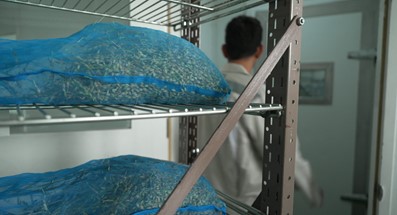Humidity and temperature
You have already learned that seeds arriving at a genebank may be immature, or may contain more moisture than is optimal for longevity in storage. This may happen if weather conditions in the field are poor, or if the seed’s natural dispersal mechanisms make it expedient to harvest before the seeds shatter and become spread over the ground, therefore lost to science. In this situation, once the immature seeds arrive at the genebank, they can mature under safe conditions in the drying rooms.
Many genebanks dry seeds according to the Genebank Standards: at temperatures between 10 and 25°C, and humidity between 10 and 15%. This contrasts with traditional practices of farmers in countries with hot, dry climates, who leave their crops out to dry in the sun, where temperatures can be around 40°C. The traditional method is low cost and tried and tested, although from a genebank’s point of view, it has limitations: prolonged exposure to the sun can damage seeds and cause a reduction in viability, and drying outside can be impractical during the rainy season.
So which of these two approaches would you expect to be more effective – drying at high temperature, like traditional farmers, or at temperatures that are prescribed in the Genebank Standards? Scientists at IRRI set out to find out.

In the case of rice, it seems the prescription in the Genebank Standards may not be optimal for producing seeds with high viability and longevity. The IRRI researchers tested the viability of samples of Oryza sativa that had been dried according to the Genebank Standards, and compared their survival with the survival of other samples, initially dried for two days in a batch-dryer at 40–45°C, before being transferred to the drying room for the rest of the drying period. Intriguingly, initial drying at high temperatures, perhaps more akin to ideal conditions when the seeds are maturing in the field, or traditional roadside drying, had a lot to offer.
Figure 8 (below) shows the improvements in longevity that resulted from initial drying at a higher temperature. There were no negative effects, and in many cases, a significant increase in longevity (p50).
Activity 3
Allow 5 minutes for this activity
Look at Figure 8 (above). What are the improvements in longevity when the seeds were initially dried at higher temperature?
When you are ready, press 'reveal' to see our comments.
Discussion
There are no negative effects in any of these accessions, and in some cases, there are very significant positive ones. Where the bar chart reaches one hundred percent (for instance accessions 117264 and 117265) this means a doubling of p50, and in one case (accession 117274), you can see that the expected longevity was more than trebled.
Conditions in the genebank
